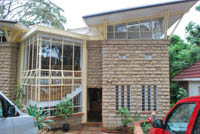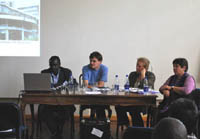You are here
- Home
- Managing Heritage, Building Peace: Museums, memorialisation and the uses of memory in Kenya
- Events
- Workshop: Shaping the Heritage Landscape
- Shaping the Heritage Landscape report
Shaping the Heritage Landscape report
Nairobi Workshop:
'Shaping the Heritage Landscape: Perspectives from East and southern Africa '
Scholars working on heritage and memory issues in East and southern Africa gathered at the British Institute in Eastern Africa (BIEA) on 5 - 6 May 2010 for this well-attended and stimulating event, which featured Professor Terence Ranger of the University of Oxford as keynote speaker on 'Conte
The workshop was organised and hosted by this research team, and funded largely by the British Academy (which funds a UK-Africa Partnership element of our research). It was an opportunity to publicly describe our work-in-progress, generously supported both by the Academy and the Arts and Humanities Research Council of the UK (AHRC), and to showcase new research on similar themes being carried out in Kenya and other parts of Africa.
The event attracted a wide cross-section of people including political scientists, historians, anthropologists, students, archivists, museologists, writers, editors, publishers and representatives from human rights groups (principally the Kenya Human Rights Commission, KHRC). We would like to thank our audience for their lively participation, which kindled intense debate - both inside the BIEA and during refreshment breaks in the garden.
Keynote address
On the evening of 5 May, Prof. Ranger spoke for 50 minutes without notes on the struggle for control of heritage and memorialization in Zimbabwe, where national commemoration has long been dominated by the political party ZANU-PF. "Party intellectuals insisted on the key importance of national rituals and monuments, holding that the legitimacy of the Mugabe regime did not depend upon regular electoral majorities, which merely confirmed it, but sprang from its revolutionary use of violence by means of an alliance of guerrillas and spirit mediums." This paper set the tone for much of the later discussion, and allowed comparisons to be drawn with state-led nationalist meta-narratives about the past in other countries, including Kenya. Too often, these do not allow for alternative voices and interpretations to be heard. A drinks reception followed.
Other papers
On day two, Dr Lotte Hughes, Prof Annie Coombes and Prof Karega-Munene individually gave brief overviews of their research work, which is in its second year of three. This was followed by a 
Some highlights
Highlighting some key points, Prof Ranger writes: "Dr Mire, the first female Somali archaeologist [and Director of Antiquities for Somaliland], developed the argument of her recent University College London doctoral thesis. She had found that archaeological remains were not important to Somalis, who derived their identity rather from their Middle Eastern religious traditions and from the 'sacred landscapes' of a pastoral environment. Remains connected either with a pre-Islamic past or with tolerant Sufi Islam were, indeed, in danger of physical destruction by radical Islamicists.
"Dr Tarsitani also spoke about the pressures of a 'Grand Tradition' on local identities, this time in Ethiopia. Under Haile Selassie only remains and artefacts associated with the dominant Christian Amharic tradition were valued and others ignored or repressed; under the 'revolutionary' Dergue past cultures were stereotyped as reactionary. But now under 'Ethnic Federalism' there has been a boom in regional museums and in the performance of regional music in Ethiopia. Belle illustrated this with particular reference to the city of Harar, where several celebrations of Harari history and culture had sprung up.
"The contrasts with Kenya were provocative. Kenyan state attitudes to regional heritage were neither directly repressive nor openly celebratory. There was not a grand master cultural narrative, religious or otherwise, nor a proclaimed ideology of ethnic federalism. State attitudes to regional initiatives were cautious and apprehensive. There was no single state version of Kenyan history of heritage - indeed, Kenyan speakers (and members of the audience) were critical of the National Museums' failure to set up a history gallery despite funding from donors and ample advice from academics. [NB: The gallery, or exhibition, is due to open later this year at Nairobi Museum, according to NMK sources]. History seemed threatening and Kenya 's regional differences had to be reduced to culture. Paradoxically, many local memorialisation initiatives seemed by contrast to be trying to build a Kenyan history piece by piece from below, emphasising both a common history of struggle against oppression and cultural traditions of peace making.

Common themes that emerged and sparked debate included:
- contestation over the custodianship of heritage and its management
- tensions between global and local initiatives, e.g. with regard to environmental protection/preservation which can privilege the global over the local
- the lack of inclusive historical narratives at national and local level
- whether heroes/heroines and 'monuments to the heroic' are a divisive or unifying force
- the challenges of commemorating liberation struggles in a balanced and inclusive way
- how to safeguard and manage heritage at all in a conflict zone, such as Somalia
- the need to move beyond objects to knowledge preservation
- official suppression of public memory and what this can lead to
- the difficulties of engaging with both public and private memory
- the impossibility, at the end of the day, of satisfying all heritage stakeholders.
Some questions from the floor, to give readers a flavour of the discussion, included:
- If Zimbabwe had no Heroes Acre created by the state, would there be another one?
- Has the opposition Movement for Democratic Change (MDC) got its own ideas about heritage? What is its view of the heroic past?
- How can we engage with alienated Kenyan youth through the language of sheng, and through targeted peace education initiatives?
Lotte Hughes, with help from Terence Ranger
> We plan to post some of the workshop papers on our website. However, several are unavailable because they are drafts of forthcoming journal articles, embargoed until publication in 2011 of a Special Issue on heritage, history and memory.
Link to photographs of the Nairobi workshop